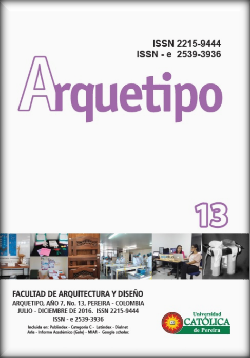Approach to participatory design on jewelry.
Keywords:
Participatory design, jewelry, Jewel gold value chain, handicraftsAbstract
The article proposes the generation of methodological models for the participatory design of jewelry lines, taking place in three jewelry communities of Risaralda, for the strengthening of the links and the weak ones of the value chain gold-jewel, like design, Innovation and added values generation. The methodological process, based on Participatory Action Research, allowed us to apply innovation and design models, taking advantage of the available technology and resources, the creative potential and cultural influence of a group of eight jewelery artisans. As a final result, a collection of jewelry was created in a participatory manner.
References
Amabile, T. (2000). Cómo matar la creatividad. En: Harvard Business Review, Creatividad e Innovación (M. E. Aparicio, Trans., pp. 1 -31). Bilbao: Deusto Ediciones.
Amabile, T. M. (1983). The sicology of creativity: A componential conceptualization. En: Journal of Personality and Social Psychology, (Vol 45(2), pp, 357-376). Asociación Estadounidense de Sicología.
Amabile, T. M. (2013). Componential theory of creativity. En: E. H. Kessler (Ed.), Encyclopedia of management theory (pp. 135–140). Thousand Oaks, CA: SAGE Publications Inc
Amabile, T. M., Conti, R., Coon, H., Lazenby, J. & Michael, H. (1996). Assessing the work Enviroment for Creativity. The Academy of Management Journal, 39 (5), 1154 - 1184.
Aznar, G. (1974). Creatividad en la Empresa. Barcelona: Oikos tau sa.
Chivas, F. (1992). Creatividad + Dinámica de Grupo = ¿Eureka? La Habana: Pueblo y educación.
Dabdoub, L. (2006). Evaluar el ambiente creativo en las organizaciones. En: S. De la Torre & V. Violant, Comprender y Evaluar la Creatividad: Cómo investigar y Evaluar la Creatividad (Vol. 2, pp. 613-624). Málaga: Ediciones Aljibe.
Fenalco (2015). Análisis Económico Sobre el Sector Joyero en Colombia. Bogotá: Fenalco.
Gardner, H. (1995). Mentes Creativas. Barcelona: Paidós.
González, C. (2012). Ambientes Creativos de Innovación. En: E. Martinez, Creatividad & Innovación (pp. 85- 136). Manizalez: Universidad Autónoma de Manizales.
Guilford, J. (1959). Three faces of intellect . American Psychologist , 14, 469-479 .
Ministerio de Minas y Energía. (2016). Politica Minera de Colombia. Bogotá: Min Minas.
Mongeotti, P. (2001). La Creatividad: Hacia un Modelo Psicológico explicativo. Revista de sicología, 18 (3), 235 -244.
Robinsong, K. (Marzo de 2011). Los Secretos de la Creatividad. Redes. (E. Punset, Entrevistador, Tve Española, Editor) Madrid.
Rothenberg, A. & Hausman, C. (1971). The Process of Janusian Thinking in Creativity. Durhan: Duke University Press.
Sternberg, R. (2012). The Assessment of Creativity: An Investment-Based Approach. Creativity Research Journal , 3-12.
Suárez Gaviria, L. (2015). Informe actividades de fortalecimiento del sector artesanal de Risaralda. Artesanías de Colombia. Pereira: Artesanías de Colombia.
Suárez Gaviria, L., Pachón, M. L. y Barrientos, J. (2013). Estudio de Prefactibilidad 3 líneas de Negocios. Cámara de Comercio de Dosquebradas - OIM. Dosquebradas: Cámara de Comercio de Dosquebradas.
Suárez, L. y Pérez, C. (2011). Artesanía y diseño: diálogos y prácticas pedagógicas. Revista Arquetipo, 2 (3), 109 - 120.
Suárez, L., Martínez, L. y Mantilla , D. (2015). Relación entre el Ambiente Creativo y Equipos Creativos. Revista Arquetipo, 6 (11), 93-106.
Tu, K. (2013). De Ferrary a los Rolling Stones: Los secretos de los mejores equipos del mundo. Bogotá: Conecta.
Woodman, R., Sawyer, J. & Griffin, R. (1993). Toward a Theory of Organizacional Creativity. Academy of Management Review , 18 (2), 293-321.

